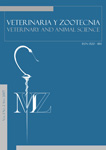Autores/as
Resumen
RESUMEN: El objetivo del presente estudio fue evaluar los cambios de pH, morfología, integridad acrosomal y supervivencia espermática, de semen diluido en BTS y refrigerado de 11 verracos (siete línea paterna y cuatro línea materna), cada 24 horas, desde 0 h (momento de recepción) hasta 120 h, tres veces con intervalos de un mes. Los análisis estadísticos se realizaron usando PROC GLM, MIXED y GENMOD de SAS (SAS Inst. Cary, NC), por medio de un modelo mixto para evaluar el efecto del tiempo de almacenamiento (TA) y de línea, sobre las variables evaluadas. Se utilizó la prueba de z2 para evaluar el efecto TA sobre células de descamación y aglutinación. A las 120 h, los espermatozoides con acrosoma normal disminuyeron; la línea materna tuvo 24,3% menos probabilidades de presentar aglutinación espermática. No se encontró efecto significativo de línea y TA sobre: morfología, pH, supervivencia espermática y presencia de células de descamación. Se concluyó que el semen porcino diluido en BTS, con 3´109 espermatozoides y refrigerado, mantiene características indicativas de viabilidad hasta las 120 h de almacenamiento. La evaluación seminal in vitro es una herramienta que ofrece la posibilidad de utilizar dosis seminales que potencialmente son desperdiciadas.
Palabras clave
Citas
Ardón, F.; Evert, M.; Beyerbach, M.; et al. Accesory sperm: a biomonitor of boar sperm fertilization capacity. Theriogenology, v.63, p.1891-1901, 2005.
Asociación Colombiana de Porcicultores-Fondo Nacional de la Porcicultura. Costos de producción para diferentes etapas en explotaciones porcinas, p.1-7, 2005. Disponible en:
Berger, T.; Turner, K.O.; Meizel, S.; et al. Zona pellucida-induced acrosoma reaction in boar sperm. Biology of Reproduction, v.40, p.525- 530, 1989.
Braundmeier, A.G.; Demers, J.M.; Shanks, R.D.; et al. The relationship of porcine sperm zona-binding ability to fertility. Journal of Animal Science, v.82, p.452-458, 2004.
Briz, M.D.; Bonet, S.; Pinart, B.; et al. Comparative study of boar sperm coming from the caput, corpus and cauda regions of the epididimis. Journal of Andrology, v.16, p.175-188, 1995.
Briz, M.D.; Bonet, S.; Pinart, B.; et al. Sperm malformations throughout the boar epididymal duct. Animal Reproduction Science, v.43, p.221- 239, 1996.
Flowers, W.L. Increasing fertilization rate of boars: Influence of number and quality of spermatozoa inseminated. Journal of Animal Science, v.80, p.E47-E53 (E. Suppl. 1), 2002.
Flowers, W.L. Detailed description of sperm motility/ morphology and causes of abnormalities. Paper presented at Midwest Boar Stud Conference II. St. Louis, MO. p.15-22, 2004.
Gadea, J.; Sellés, E.; Marco, M.A. The predictive value of porcine seminal parameters on fertility outcome under commercial conditions. Reproduction in Domestic Animals, v.39, p.303-308, 2004.
Harayama, K.; Okada, K.; Miyake, M. Involvement of cytoplasmic free calcium in boar sperm: head- to-head agglutination induced by a cell-permeable cyclic adenosine monophosphate analog. Journal of Andrology, v.24, p.91-99, 2003.
Johnson, R.K. Crossbreeding in swine: Experimental results. Journal of Animal Science, v.52, p.906- 923, 1981.
Johnson, L.A.; Weitze, K.F.; Fisher, P.; et al. Storage of boar semen. Animal Reproduction Science, v.62, p.143-172, 2000.
Legault, C. Breeding for larger litters in swine. Pork Industry Conference, Urbana, IL. p.1-26, 1983. Polakoski, K.L.; McRorie, R.A. Boar acrosin. II classification, inhibition and specificity studies of a proteinasa from sperm acrosome. The Journal of Biological Chemistry, v.248, p.8183-8188, 1973.
Pursel, V.G.; Johnson, L.A.; Rampacek, G.B. Acrosome morphology of boar spermatozoa incubated before cold shock. Journal of Animal Science, v.34, p.278-283, 1972a.
Pursel, V.G.; Johnson, L.A.; Schulman, L.L. Interaction of extender composition and incubation period on cold shock susceptibility of boar spermatozoa. Journal of Animal Science, v.35, p.580-584, 1972b.
Rozeboom, K.J. Evaluating of boar semen quality. Animal Science Facts. Publication number ANS 00-812S. Extension Swine Husbandry. College of Agriculture & Life Sciences. North Carolina State University. p.1-8, 2000. Disponible en:
Schlecht, U.; Demougin, P.; Koch, R.; et al. Expression profiling of mammalian male meiosis and gametogenesis identifies novel candidate genes for roles in the regulation of fertility. Molecular Biology of the cell, v.15, p.1031-1043, 2004.
Schmidt, H.; Kamp, G. Induced hyperactivity in boar spermatozoa and its evaluation by computer- assisted sperm analysis. Reproduction, v.128, p.171-179, 2004.
Sutkevičienë, N.; Ţilinskas, H. Sperm morphology and fertility in artificial insemination boar. Veterinaija ir Zootechnika, v.26, p.11-13, 2004. Tess, M.W.; Bennett, G.L.; Dickerson, G.E. Simulation of genetic changes in life cycle efficiency of pork production. II. Effects of components on efficiency. Journal of Animal Science, v.56, p.354-368, 1983.
Vyt, P.; Maes, D.; Dejonckheere, E.; et al. Comparative study on five different commercial extenders for boar semen. Reproduction in Domestic Animals, v.39, p.1-8, 2004.

 PDF
PDF
 FLIP
FLIP










